The drive up to Lowestoft on Friday was without problems but
frustratingly I missed the Walberswick Red-rumped Swallows by ten minutes and
they had not returned in my allotted hour.
I spent my time watching the Barnacle Geese and a splendid Little Egret
while catching up with friends lingering on the river wall. A couple of Common Darters and a Red Admiral
were there to fool us in to thinking it was not November.
 |
| Little Egret |
Saturday 12th November:
In retrospect I should have tweaked the starting point for
Saturday morning and begun at the Swallows (which we would then have seen) but hindsight
is a wonderful thing and I stuck to my plan to begin south and head north and
we met in the main car park at North Warren at 0800. It was a glorious morning with a lovely
sunrise that illuminated the marshes inland in a golden light that made the assembled
duck simply glow.
The number of Pintail was especially pleasing and you could
even see a little of that seldom seen green and purple glow in the cheeks of
the males. There were Wigeon, Teal,
Shoveler and a couple of Mallard and singles of Pink-foot and Canada amongst
the Greylags while the large Barnacle flock was keeping to itself in with the
cattle.
 |
| Pintail |
 |
| Pintail - Mark Vale |
 |
| Pintail - Mark Vale |
 |
| Mute Swans - Mark Vale |
 |
| Barnacle Geese |
Snipe and Lapwing were out on the pools and a Little Egret
was foot shuffling in the shallows. Skylarks
and Meadow Pipits were out there too but there were also quite a few on the
shingle beach where Greenfinches, Linnets and the odd Goldfinch fed.
The bushes held strangely showy but still shouty Cetti’s
Warblers, a brief Dartford Warbler, Robins, Dunnocks, Wrens and Stonechats and
all were keeping an eye on the hovering Kestrel along the verge.
 |
| Greenfinch |
 |
| Stonechat |
 |
| Stonechat - Mark Vale |
 |
| Kestrel - Marion Bertuzzo |
 |
Jackdaw - Antony Wren
|
 |
House in the Clouds - Thorpeness - Antony Wren
|

The Swallows were meant to be next but they had already
departed so after some faffing around (sorry Marion) we went to Westleton Heath
instead. Layers were removed for the walk
– it was warm, still and clear but our circuit was rather oddly quiet with just
a couple of Stonechats out on the heather and not a hint of a Dartford Warbler
until we were almost back at the car where a Long-tailed Tit flock with a
couple of Goldcrests detained us and somehow drew in both Stonechats and a fine
male Darty which showed rather nicely.
 |
| Robin |
The lack of birdlife was made up for by regular encounters
with basking Common Darters on the paths along with a single Migrant Hawker and
three Butterfly species with Red Admiral, two Peacock and a Small Tortoiseshell
still on the wing. The Gorse was in full
flower in places and was even warm enough to be giving off its coconut scent. The Honey Bees and a few Bombus terrestris
and lapidarius seemed happy to find it.
 |
| Common Darter |
 |
| Gorse |
 |
| Peacock |
There were a few fungi around the edges including some Fly
Agaric that had gone over. They looked a little odd as these ones would have come up
in the rain, hence soil still on top. The white bits had then washed off, and
the red pigment, being water-soluble had washed out to orange. Thanks to Antony
and Su for their input.
 |
| Fly Agaric |
Needless to say, where there are leaves there are moth mines
and there were plenty to find which kept Antony happy and allowed him to share
his knowledge with the group too. Soon
enough everyone was finding green islands in the Sweet Chestnut, Birch and Oak
leaves. I found one that he was particularly
pleased with on an Oak leaf - Tischeria
dodonaea – which looks a bit like a ring of concentric circles and was
only the second he had seen.
 |
| Tischeria dodonaea and Ectoedemia subbimaculella |
 |
| Ectoedemia albifasciella on English Oak |
 |
| Ectoedemia occultella on Birch |
 |
| Gypsonoma dealbana on English Oak |
 |
| Stigmella confusella on Birch |
.JPG) |
| Stigmella luteella on Birch |
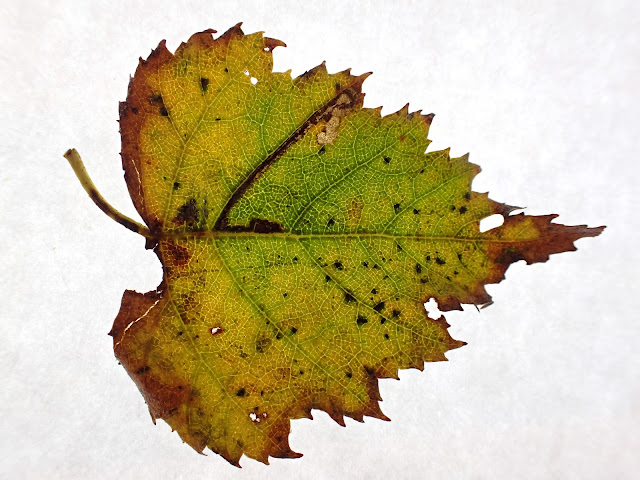 |
| Stigmella luteella on Birch |
 |
| Tischeria ekebladella on English Oak |
All the above mines taken and identified by Antony Wren
I opted for lunch at Dunwich Beach (always good to know
where toilets are and of course Antony wanted to check for moths…) but despite
being able to sit on the shingle bank and eat lunch there were almost no birds
to be seen out on the marshes with just two Black-headed Gulls and a Carrion
Crow!
An Adonis Ladybird landed on my shoulder and subsequently
performed for the camera. This was a new species for everyone else. Just before we left an immature male Marsh
Harrier put on a show over the closest reedbed and Reed Buntings and Stonechats flitted about
the Phragmites heads.
 |
| Adonis Ladybird - Antony Wren |
News that the Swallows were back had us heading for Walberswick
once more but they had moved and after some quality convoying we arrived at the
car park for Westwood Marshes to the south of the village. The walk down through the trees was full of
fungi including a couple of red Fly Agarics.
The light had changed and everything was becoming grey and hazy but I think
we were all surprised to pop out into the open and find ourselves in the midst
of a vast reedbed that quite literally stretched as far as we could see.
 |
| Fly Agaric - that's better! |
Of the errant Swallows there was no sign (quelle surprise!)
but Marsh Harriers quartered back and forth and Reed Buntings flicked around. There must be Bitterns, Water Rails and
Bearded Tits galore lurking therein!
I had a vague hope that they would head to the Ferry area so
we ambled back through the woods seeing Goldcrests and hearing Treecreepers,
Coal Tits and a Bullfinch – there may have been some more leafmine action.
.jpg) |
1 Tischeria dodonaea, 2 Ectoedemia subbimaculella and 3 Tischeria ekebladella on Oak
|
 |
| Ectoedemia quinquella on Oak - tiny wiggles in green islands. Amazing to think that the tiny moth grub gives out enzymes that keep it green! |
 |
| Ectoedemia subbimaculella on English Oak |
.JPG) |
| Phyllonorycter ulmifoliella on Birch |
 |
| Stigmella viscerella on Elm |
The last hour of the day was spent at Walberswick where of
course the Swallows never returned (and we even dipped out on Ed Sheeran) but
Antony found a brute of an adult Caspian Gull with the other species on the
harbour wall and amongst the horde of Barnacle Geese I picked up a very small
Canada Goose that appeared to tick all the right boxes but unfortunately may
still show one or two signs that at some stage it had Barnacle Goose in its
parentage.
 |
| Caspian Gull |
 |
| Annoying small goose |
 |
| Barnacle Geese - Mark Vale |
 |
| Barnacle Geese |
Seeing such a huge flock of these striking Geese is always
special and watching them lift off and circle the marshes took me back to Caerlaverock
all those years ago.
 |
| Barnacle Geese - that small Canada too |
With the light fading before sunset we called it a day.
13th November:
Sunday was a lazy day Chez Wren but there were nine
immigrant Blackbirds with a Song Thrush in the trees beyond the garden first
thing and a trio of gems from the moth trap – two of which I had not seen before.
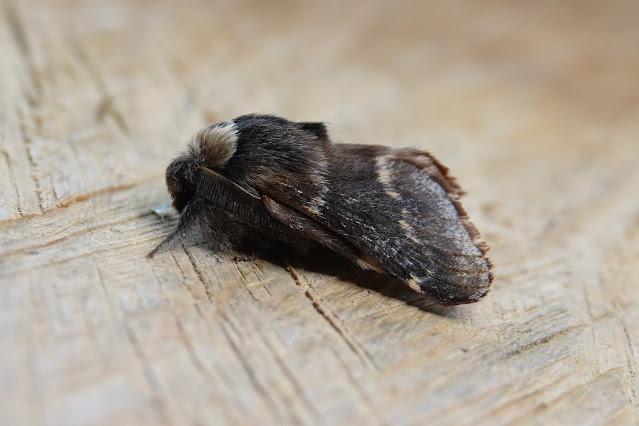 |
| December Moth - looks like a Musk Ox |
 |
| December Moth |
 |
| Merveille de Jour |
 |
| Merveille de Jour |
 |
| Cypress Carpet |
 |
| Cypress Carpet |
Antony and I pottered out before dinner down to Kessingland
Beach through The Hollies. Annoyingly a
Swallow flying around distantly stubbornly refused to be a Red-rumped while
high above 22 spooked Snow Bunting circled with two noisy Dunlin before dropping
down onto that amazing beach below.
Eight Barnacle Geese headed north and offshore it soon became
apparent that the wildfowl movement that had been noted during the day by
others was ongoing and in that forty minutes before 4.30 we counted 308
Dark-bellied Brent Geese in snaky lines heading south along with two Greylags,
146 Wigeon, 78 Pintail, ten Teal, four Mallard and a Shelduck. A distant high flock of Geese felt like they
were going to be grey geese and despite the failing light we could just make
out the dark belly bars on some as 50 Russian White-fronts tracked down the
coast. Given that the sun was merely pinking
up the sky it was an absolute joy to witness even the tail end of the day’s passage.
 |
| Mostly Pintail, two Greylags and some Brents |
 |
| Dark-bellied Brent Geese |
 |
| Dark-bellied Brent Geese |
 |
| Dark-bellied Brent Geese |
 |
| Russian White-fronted Geese |
 |
| Russian White-fronted Geese - the sun had set |
 |
| Sun Dog |
 |
| Amazing how quickly the colours changed |
Hundreds of gulls were drifting in to roost on the sea and
an adult Med Gull was amongst them before we decided that we should really tackle
the steep steps back up to the top with some vestige of light remaining. Winter song Robins welcomed the night as we
made our way back to the car and the roast lamb dinner awaiting us back home.
We both made it back to the top without stopping - stupid boys























.JPG)




.jpg)


.JPG)
























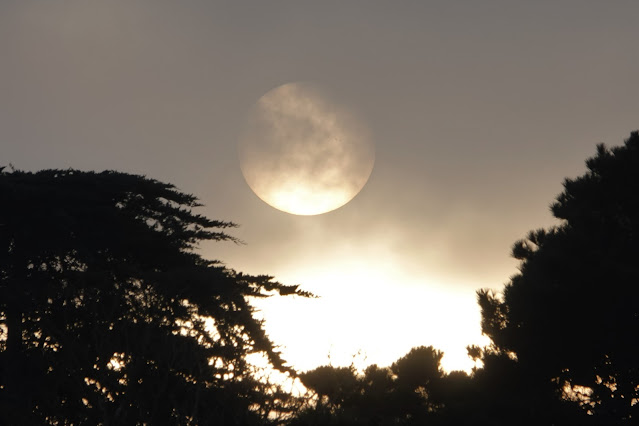



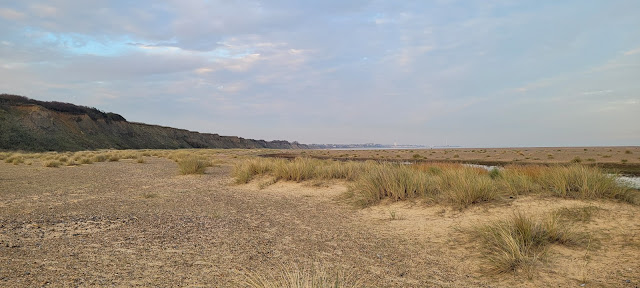
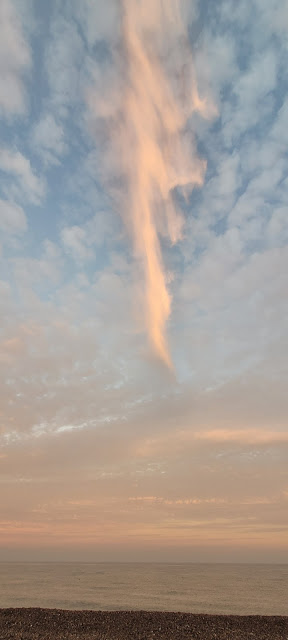


No comments:
Post a Comment